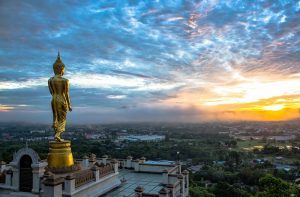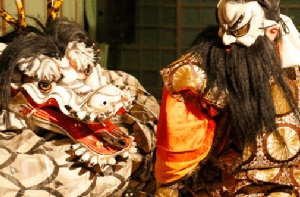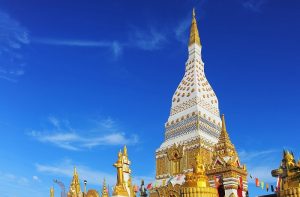The Road Less Travelled to Nan

The unseen province of Nan, located in northern Thailand, is remote even by Thai standards. But those who take the time to travel to Nan are rewarded with a relaxed destination rich in both culture and history.
Surrounded by the spectacular misty mountains of Doi Phu Kha National Park, Nan is home to many old temples and teak wooden houses, where foreign tourists are rare and locals still enjoy the traditional slow lifestyle of northern Thailand.
The town is the capital of the province of the same name; home to hill-tribe villages in the high mountains, abundant waterfalls, and no less than seven national parks. It’s ancient temples in Tai Lue style, lush green mountains, sleepy local villages, and indigenous communities are starting to attract Thai and foreign tourists alike.
Nan’s main attractions – such as the famous Wat Phumin – sees many local visitors, however in other districts life remains peaceful and rich with local arts and ceremonies. Enjoy the stunning panoramic views over Nan from the hilltop at Wat Phra That Khao Noi; spend a few hours marvelling at the exhibitions at Nan Riverside Art Gallery located on the banks of the Nan River, or simply relax and enjoy the tranquil atmosphere.
For more information on our Lanna Kingdom – The Road Less Travelled 4D/3N programme, visit the Agent Hub.
Kagura and Craft Experience in Yunotsu

The San’in Region is situated just behind Hiroshima and Okayama but separated by the Chugoku Mountains. This natural barrier between them makes the San’in region the last hidden gem in Western Japan. Consisting of two prefectures, Shimane and Tottori – which have historically been the least populated prefectures in the country – San’in is still relatively unknown to foreign travellers and allows those seeking a journey off the beaten path and to venture into the heart of Japan.
While many smaller hot spring resorts of rural Japan are quietly falling into decay, the town of Yunotsu in Shimane stands out for being highly cared for and retaining its traditional charm. Together with nearby Iwami Ginzan, Yunotsu has even been listed as a UNESCO World Heritage Site. In modern times, Yunotsu is full of energy and excitement every Saturday night thanks to the regular Kagura performances.
Kagura is an ancient form of music and masked dance theatre dedicated to Shinto gods and can be found all over Japan. This particular variety, originating from the Western part of Shimane, is called Iwami-Kagura and features faster and more aggressive movements compared to other varieties, as well as dramatic sound and lighting effects. Transcending language and culture, these performances are easy to follow as they depict stories of battles between good and evil, the most famous being the god Susanoo fighting against the giant eight-headed serpent, Orochi.
Join Destination Asia Japan on an exclusive tour and get front-row seats to this unique dance at a local shrine. Following the experience, get private insider access to a traditional Kagura mask designer – one of the few surviving practitioners to this day – watch him at work and even try your hand at making your own.
For more information on our Kagura, a Masked Dance Theatre Night in Yunotsu – Add On and Kagura Mask Artisan Visit in Yunotsu – Add On programmes, visit the Agent Hub.
Isaan Culture and Natural Wonders Along the Mekong River

The Mekong River, one of the world’s longest rivers, marks the border between the province of Nakhon Phanom and neighbouring Laos. After settling into the hotel visit some of the local highlights that the town has to offer, including: Saint Anna Nong Saeng Church, the Provincial Governor’s Residence Museum, then Indochina market, Wat Okad (Sribuaban) Temple alongside the Mekong River embankment, as well as Ho Chi Minh’s residence on the outskirts of Nakhon Phanom – the safe house that the former president lived in for several years from 1923. In the evening, take to the river for a dinner cruise along Mekong River and admire the scenery of the Thai-Laos border.
Meet the Phu Thai community, an ethnic minority who have retained their ancient culture in the form of dances and traditions, before continuing on to Ubon Ratchathani via Mukdaharn province and cruising along the Mekong River to Sam Pan Boak, known locally as the ‘Grand Canyon of Thailand’. Here, visit Pha Taem Historical Park with its numerous prehistoric cave paintings and unique rock formations, and take in the beauty of these sheer sandstone cliffs that thrusted up as a result from earthquakes centuries ago.
A cluster of towering mushroom-shaped rock formations known as Sao Chaliang is also worth a stop and if time permits visit one of Thailand’s more distinctive waterfalls, Saeng Chan, which tumbles through a hole in an overhang of rock coloured orange and olive green from fungi.
For more information on our Along Mekong 3D/2N programme, visit the Agent Hub.